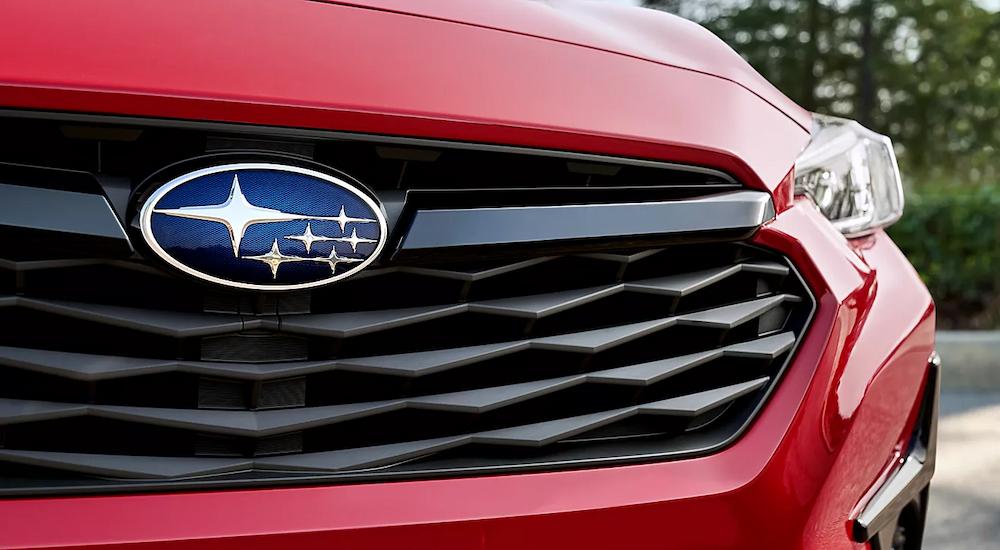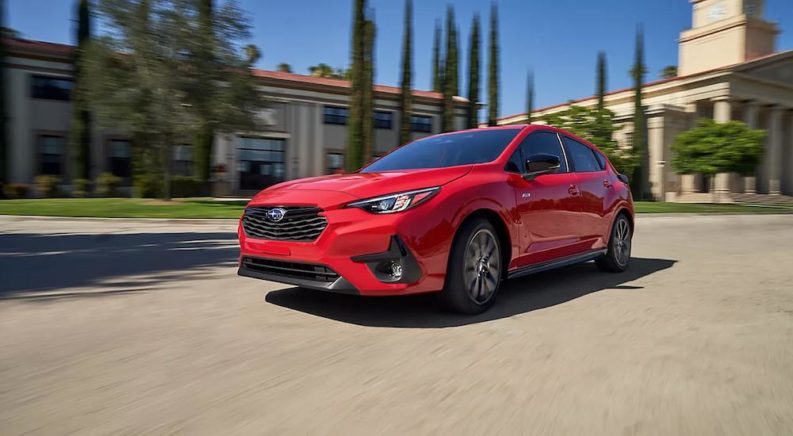Who doesn’t appreciate a good underdog story? Most drivers don’t associate Subaru with racing unless they’re avid car fanatics or longtime devotees of the Subaru name. Instead, the automaker has built its reputation around reliability, versatility, and practicality. As a result, Subaru carved its niche in the industry, favoring the Boxer engine and standardizing its Symmetrical All-Wheel Drive across most of its lineup. However, there’s another side to Subaru.
That side sits far beyond what most drivers know about Subaru, but the brand is making it more mainstream with the 2024 Subaru Impreza, which marks the return of the legendary RS trim. The RS might be a new trim for younger generations, but for others, it’s the return of the Impreza that once set the stage for the WRX’s debut on American soil and introduced more of us to Subaru’s racing history. The RS is a living embodiment of Subaru’s racing heritage, a legacy that upends its Mr. Rogers-esque reputation with a need for speed and the capability to deliver.
What makes Subaru the underdog? Like so many other automotive pioneers, Subaru had to fail before it could succeed. Its foray into the racing circuit didn’t start with a bang, and instead, ended in laughter as Subaru learned the hard way that it didn’t have the heart to play in the Formula 1 circuit against legends like Ferrari and Alfa Romeo.
Casting Its Net Too Wide
Japan’s economy flourished in the 1980s, prompting Subaru to cash in on the financial gains by casting a wider net to attract more drivers to the brand. The idea was simple: Subaru wanted to transition its reputation for practicality to the Formula 1 circuit. The plan was to act as an engine supplier with a twelve-cylinder Boxer engine, a logical progression to complement the four-cylinder and six-cylinder options that characterized its lineup at the time. However, Subaru gave little thought to the practicality of a twelve-cylinder Boxer engine in Formula 1 racing, ignoring that the last successful user of such an engine, Ferrari, had dropped it after the 1981 season.
Oblivious to reality, Subaru partnered with Motori Moderni, a company founded by the former Formula 1 chief engineer for Alfa Romeo. However, even with such a stellar reputation, the partnership proved futile. Moderni’s 3.5L Boxer engine became Subaru’s worst nightmare, weighing nearly 250 lbs more than other Formula 1 engines and achieving just 550 hp. With rival engines weighing considerably less and delivering upwards of 600 hp, Subaru’s fate in Formula 1 racing was doomed before it ever began.
Despite its engine being overweight and underpowered, Subaru bought 51% of the Scuderia Coloni racing team and installed the engine in its car for the 1990 season. However, additional modifications caused even more problems, leaving the team with eight failed attempts to even qualify. As a result, Subaru sold its shares in Coloni, which returned to using a Ford-Cosworth V8 for the remainder of the season. Subaru’s Formula 1 racing dreams were over, and the automaker had nothing to show for it except humiliation.

Shifting Perspective: From Performance to Practicality
Although Subaru became the laughingstock of Formula 1, the experience taught the automaker a valuable lesson. Instead of focusing all its efforts on something beyond its reach, Subaru learned the value of shifting its perspective to its talents. Already well-established for its practical lineup, Subaru had honed in on that reputation and began dabbing in rally car races in the early 1970s when it entered a Leone in the Southern Cross Rally in Australia.
This first taste of speed was enough to send Subaru on a trajectory that was the exact opposite of its massive failure in Formula 1. As the company was throwing its hat in the ring of Formula 1, Subaru also formed Subaru Tecnica International. Within a year, STI developed its first race car––a Legacy RS that delivered 220 hp––and broke an FIA World Speed Endurance Record in 1989 by driving 62,000 miles in 20 days, averaging 138 mph.
Although the Legacy RS was promising, Subaru knew, this time from experience and history, that it needed a vehicle better suited to racing. In the meantime, Scottish driver Colin McRae got behind the wheel of the Legacy and earned Subaru its first World Rally Championship title in New Zealand. Behind the scenes, Subaru busily worked on a new model––the Impreza WRX or the “World Rally eXperimental.” Subaru was finally a contender in the racing circuit, winning three consecutive titles throughout the 1990s and nearly 50 others since.
Why Rally Car Racing?
While Subaru’s twelve-cylinder Boxer failure was enough to sour the automaker’s taste for Formula 1 racing, shifting its efforts to rally was a winning move. Why? Formula 1 is designed for speed and cornering, with top speeds reaching over 200 mph on straightaways as drivers navigate a closed loop on a dedicated circuit. Formula 1 models are bred to perform, which Subaru discovered it couldn’t produce.
The failure forced Subaru to pivot, as the automaker quietly turned its attention to rally car racing. Instead of needing a purpose-built racehorse, Subaru realized it could modify an existing model like the Legacy to deliver more responsive handling and faster acceleration. It was a winning combination that added appeal to the Subaru lineup.
World Rally Championships aren’t closed-circuit races. Instead, they are run on a course that travels across everything from gravel and pavement to snow and ice in every weather condition imaginable. The conditions are closer to reality than a closed-circuit loop, which makes rally cars more relatable to everyday drivers. Who is Subaru’s primary customer group? Daily drivers who flock to the brand because of its reliability.
As expected, the swap from Formula 1 to rally car racing proved lucrative. When Subaru won a World Rally Championship title, drivers flocked to Subaru dealerships across the country, knowing they could drive a similar model. Would it offer the same performance-oriented speed and handling? No, but it was close enough to the real thing and came bearing the Subaru name. For many drivers, that’s been good enough.
The 2024 Impreza RS
The Impreza RS debuted in 1998 amid Subaru’s growing success in rally racing. Powered by a 2.5L Boxer engine, the Impreza RS set the stage for the more powerful and agile WRX. Today, the Impreza and the WRX have differentiated themselves with the rally-inspired model recognized for its on-road prowess and handling. Where does that leave the newly reintroduced 2024 Impreza RS?
The RS gives drivers a taste of Subaru’s racing heritage with its more powerful 2.5L Boxer engine and Lineartronic continuously variable transmission. Subaru discontinued the Impreza’s manual transmission for 2024 but gave drivers some control over the RS’s performance with an eight-speed manual mode and steering wheel-mounted paddle shifters. Beyond this, you can expect the RS to offer distinct badging that celebrates its heritage and an exclusive interior replete with leather and carbon fiber accents, black cloth seats, and red bolsters for a performance-oriented aesthetic.
The 2024 Impreza RS’s packaging provides what Subaru does best: practicality and versatility. As history has proven, the hatchback won’t win any Formula 1 races, nor will it beat an everyday muscle car like the Dodge Charger or Ford Mustang on a straightaway. However, it does give drivers a taste of Subaru’s penchant for rally-like handling and performance. Moreover, it reminds us of an underdog story where a massive failure led to Subaru’s ongoing success in the pursuit of incredible speed and agility.




